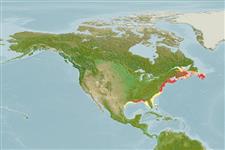Environment: milieu / climate zone / depth range / distribution range
पारिस्थितिकी
समुद्री; स्वच्छ जल, अलवण जल; खारा ड़िमरसल; ऐनाढरोमस (Ref. 51243); गहराई सीमा 30 - ? m (Ref. 2850). Temperate; 8°C - 25°C (Ref. 47172); 49°N - 27°N, 94°W - 59°W (Ref. 86798)
Western Atlantic: St. Lawrence River in Quebec, Canada to Lake Pontchartrain in Louisiana; south in Florida, USA to St. Johns and Suwannee river drainages.
आकार / वज़न / Age
Maturity: Lm ? range ? - ? cm
Max length : 200 cm TL पुल्लिंग / अलिंग; (Ref. 86798); common length : 120 cm TL पुल्लिंग / अलिंग; (Ref. 9988); अधिकतम प्रकाशित वज़न: 57.0 kg (Ref. 2850); अधिकतम सूचित उम्र: 30 वर्षो (Ref. 1468)
पृष्ठीय रीढ़ (सम्पूर्ण): 9 - 11; पृष्ठीय सौफट रेज़ (सम्पूर्ण): 10-13; गुदा कांटा 3; ऐनल सौफट रेज़: 7 - 13
Inhabit coastal waters and are commonly found in bays but may enter rivers in the spring to spawn (Ref. 2850). Some populations are landlocked (Ref. 7251). Voracious and opportunistic feeder (Ref. 5951). Larvae feed on zooplankton; juveniles take in small shrimps and other crustaceans, annelid worms, and insects (Ref. 1998, 10294); adults feed on a wide variety of fishes (alewives, herring, smelt, eels, flounders, mummichogs, rock gunnels, sand lance, silver hake and silversides (Ref. 5951)) and invertebrates (squid, crabs, sea worms and amphipods (Ref. 5951)), mainly crustaceans (Ref. 1998). Feeding ceases shortly before spawning (Ref. 1998). Utilized fresh and eaten broiled and baked (Ref. 9988).
Move into fresh or brackish water to spawn (Ref. 39467). Females spawn more than once in a season, but they don't necessarily spawn every year (Ref. 1998).
Heemstra, P.C., 1995. Moronidae. Lubinas. p. 1289-1292. In W. Fischer, F. Krupp, W. Schneider, C. Sommer, K.E. Carpenter and V. Niem (eds.) Guia FAO para Identification de Especies para lo Fines de la Pesca. Pacifico Centro-Oriental. 3 Vols. FAO, Rome. (Ref. 9320)
IUCN Red List Status (Ref. 130435)
Warning: mysqli::__construct(): (HY000/1040): Too many connections in /var/www/html/includes/func_getlabel.php on line 46
Can't connect to MySQL database (fbapp). Errorcode: Too many connections
